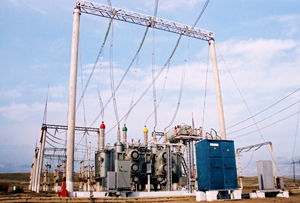Home page
» ECONOMY
» Power engineering
Power engineering The period of speedy development of power engineering in Azerbaijan, which has a history of more than a century, has begun since 1970. In order to meet the increasing heat and electricity demands of “growing Sumgait industrial region, the capacity of Sumgait Heat Energy Center” №2 was planned to be increased and last-fourth turbine generator was put into operation in 1972. Thus, the power capacity of the station reached 220 MVt. This allowed for the improvement of energy supply of the industrial region. In order to develop agriculture in Garabakh, to built reservoir for the irrigation of productive lands, to improve electrical power supply of the region, to reduce wastes in the energy transmission, Serseng reservoir and a hydroelectric power station of the same name with 50MVt power capacity were put into operation on the Terter River in 1976-1977. Currently, this object is in the areas which are under temporary Armenian occupation. In the late 1970s, the electric station in the republic with the total power capacity of 2882 MVt produced electrical power of 15.4 billion KVt-hour. However, the increasing demand of the rapidly developing economy made Azerbaijan to export 2.9-3.5 billion KVt-hour electrical power from the neighboring countries in order to fill this gap, it was decided to begin the construction of Shemkir HPS and Azerbaijan TPS as soon as possible. Since the 1980s, Azerbaijan has not only been able to supply itself with electric power, but exported a part of energy to the neighboring countries as well. In those years, all residential places of Azerbaijan, every house in our republic was supplied with electricity. If in 1969, Azerbaijan was a country which imported electric power from abroad, 1982 it became an exporter of electric power. In that period besides the construction of power stations, electricity networks were systematically improved and a stably power system was formed in the Republic as well. In the 1968-71, Ali-Bayramli (now Shirvan) DRES-Agdam-Gandja-Agstafa line 330 KVt, and Ali-Bayramli DRES. Yashma-Derbend high- voltage lines were constructed; “Yashma”, “Gandja”, and “Agstafa” junction sub-stations of 330/110/20 kV were put into operation. The construction of Azerbaijan TES was the beginning of a new stage in the development of energy network in the republic. 1st Absheron PTC of 500 kV power, 2nd Absheron ETL, Mukrani-Veli ETL (now partly destroyed), 4th and 5th Mingechevir ETL were built. In the 1980s, junction sub-stations, such as “Absheron” of 500/330/220 kV, “Imishli” of 330/110/10 kV, “Hovsan”, “Nizami”, “Mushviq”, “Sengechal”, “Masalli”, “Agsu”, Babek of 220/110/10 kV power Ali-Bayramli ETL of 330 KVt were put into operation. The collapse of the Soviet Union affected power engineering as well. However, strategic policy directed to establish mutually advantageous relations with the loading countries of the world allowed for attracting and these opportunities are purposefully used for the increase of the efficiency of current potential of Azerbaijan power system, the reconstruction of power engineering economy and construction of new powers until now. In 1995, 17 billion kV-hours electric power was produced in the Republic, and it comprised more than 97% of consumption at that period. The rest part was met with the help of energy importing. The construction of Yenikend water reservoir and hydroelectric power station that was the continuation half-done since 1984, laid the foundation of new development stage in the power system. The European Bank for Reconstruction and Development allocated a credit amounting 53.24 million USD for the construction of Yenikend Hydroelectric Power Station, thanks to the intensive work or power engineers and builders, the station was put into operation in December 2000, and production of electrical power was started. Substantial measures were taken for the formation of legislative basis in the power engineering sector, and improvement of legal basis concerning this field. Several laws were passed on power engineering, including the law on “Power Engineering”, “The Use of Energy Resources”, “Electrical Power Engineering”, “Electric and Thermal stations”, etc.
|
